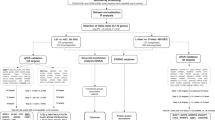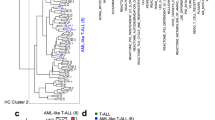Abstract
Hematologic malignancies are characterized by fusion genes of biological/clinical importance. Immortalized cell lines with such aberrations are today widely used to model different aspects of leukemogenesis. Using cDNA microarrays, we determined the gene expression profiles of 40 cell lines as well as of primary leukemias harboring 11q23/MLL rearrangements, t(1;19)[TCF3/PBX1], t(12;21)[ETV6/RUNX1], t(8;21)[RUNX1/CBFA2T1], t(8;14)[IGH@/MYC], t(8;14)[TRA@/MYC], t(9;22)[BCR/ABL1], t(10;11)[PICALM/MLLT10], t(15;17)[PML/RARA], or inv(16)[CBFB/MYH11]. Unsupervised classification revealed that hematopoietic cell lines of diverse origin, but with the same primary genetic changes, segregated together, suggesting that pathogenetically important regulatory networks remain conserved despite numerous passages. Moreover, primary leukemias cosegregated with cell lines carrying identical genetic rearrangements, further supporting that critical regulatory pathways remain intact in hematopoietic cell lines. Transcriptional signatures correlating with clinical subtypes/primary genetic changes were identified and annotated based on their biological/molecular properties and chromosomal localization. Furthermore, the expression profile of tyrosine kinase-encoding genes was investigated, identifying several differentially expressed members, segregating with primary genetic changes, which may be targeted with tyrosine kinase inhibitors. The identified conserved signatures are likely to reflect regulatory networks of importance for the transforming abilities of the primary genetic changes and offer important pathogenetic insights as well as a number of targets for future rational drug design.
This is a preview of subscription content, access via your institution
Access options
Subscribe to this journal
Receive 12 print issues and online access
$259.00 per year
only $21.58 per issue
Buy this article
- Purchase on Springer Link
- Instant access to full article PDF
Prices may be subject to local taxes which are calculated during checkout


Similar content being viewed by others
References
Rowley JD . The critical role of chromosome translocations in human leukemias. Annu Rev Genet 1998; 32: 495–519.
Mitelman F, Johansson B, Mertens F . Fusion genes and rearranged genes as a linear function of chromosome aberrations in cancer. Nat Genet 2004; 36: 331–334.
Downing JR . AML1/CBFbeta transcription complex: its role in normal hematopoiesis and leukemia. Leukemia 2001; 15: 664–665.
Scandura JM, Boccuni P, Cammenga J, Nimer SD . Transcription factor fusions in acute leukemia: variations on a theme. Oncogene 2002; 21: 3422–3444.
Cross NC, Reiter A . Tyrosine kinase fusion genes in chronic myeloproliferative diseases. Leukemia 2002; 16: 1207–1212.
Deininger MW, Goldman JM, Melo JV . The molecular biology of chronic myeloid leukemia. Blood 2000; 96: 3343–3356.
Golub TR, Slonim DK, Tamayo P, Huard C, Gaasenbeek M, Mesirov JP et al. Molecular classification of cancer: class discovery and class prediction by gene expression monitoring. Science 1999; 286: 531–537.
Yeoh EJ, Ross ME, Shurtleff SA, Williams WK, Patel D, Mahfouz R et al. Classification, subtype discovery, and prediction of outcome in pediatric acute lymphoblastic leukemia by gene expression profiling. Cancer Cell 2002; 1: 133–143.
Valk PJ, Verhaak RG, Beijen MA, Erpelinck CA, Barjesteh van Waalwijk van Doorn-Khosrovani S, Boer JM et al. Prognostically useful gene-expression profiles in acute myeloid leukemia. N Engl J Med 2004; 350: 1617–1628.
Bullinger L, Dohner K, Bair E, Frohling S, Schlenk RF, Tibshirani R et al. Use of gene-expression profiling to identify prognostic subclasses in adult acute myeloid leukemia. N Engl J Med 2004; 350: 1605–1616.
Drexler HG, Matsuo AY, MacLeod RA . Continuous hematopoietic cell lines as model systems for leukemia-lymphoma research. Leuk Res 2000; 24: 881–911.
Druker BJ, Lydon NB . Lessons learned from the development of an abl tyrosine kinase inhibitor for chronic myelogenous leukemia. J Clin Invest 2000; 105: 3–7.
Fine BM, Stanulla M, Schrappe M, Ho M, Viehmann S, Harbott J et al. Gene expression patterns associated with recurrent chromosomal translocations in acute lymphoblastic leukemia. Blood 2004; 103: 1043–1049.
Saal LH, Troein C, Vallon-Christersson J, Gruvberger S, Borg A, Peterson C . BioArray Software Environment (BASE): a platform for comprehensive management and analysis of microarray data. Genome Biol 2002; 3:SOFTWARE0003.
Yang YH, Dudoit S, Luu P, Lin DM, Peng V, Ngai J et al. Normalization for cDNA microarray data: a robust composite method addressing single and multiple slide systematic variation. Nucleic Acids Res 2002; 30: e15.
Saeed AI, Sharov V, White J, Li J, Liang W, Bhagabati N et al. TM4: a free, open-source system for microarray data management and analysis. Biotechniques 2003; 34: 374–378.
Nilsson J, Fioretos T, Höglund M, Fontes M . Approximate geodesic distances reveal biologically relevant structures in microarray data. Bioinformatics 2004; 20: 874–880.
Tenenbaum JB, de Silva V, Langford JC . A global geometric framework for nonlinear dimensionality reduction. Science 2000; 290: 2319–2323.
Hosack DA, Dennis Jr G, Sherman BT, Lane HC, Lempicki RA . Identifying biological themes within lists of genes with EASE. Genome Biol 2003; 4: R70.
Sambrook J, Fritsch EF, Maniatis T . Molecular Cloning: a Laboratory Manual, 2nd edn. NY: Cold Spring Harbor, 1989.
Håkansson P, Segal D, Lassen C, Gullberg U, Morse H, Fioretos T et al. Identification of genes differentially regulated by the P210 BCR/ABL1 fusion oncogene using cDNA microarrays. Exp Hematol 2004; 32: 476–482.
Fioretos T, Nilsson PG, Aman P, Heim S, Kristoffersson U, Malm C et al. Clinical impact of breakpoint position within M-bcr in chronic myeloid leukemia. Leukemia 1993; 7: 1225–1231.
Gschwind A, Fischer OM, Ullrich A . Timeline: the discovery of receptor tyrosine kinases: targets for cancer therapy. Nat Rev Cancer 2004; 4: 361–370.
Stirewalt DL, Meshinchi S, Radich JP . Molecular targets in acute myelogenous leukemia. Blood Rev 2003; 17: 15–23.
Schoch C, Schnittger S, Klaus M, Kern W, Hiddemann W, Haferlach T . AML with 11q23/MLL abnormalities as defined by the WHO classification: incidence, partner chromosomes, FAB subtype, age distribution, and prognostic impact in an unselected series of 1897 cytogenetically analyzed AML cases. Blood 2003; 102: 2395–2402.
Nosaka T, Kitamura T . Pim-1 expression is sufficient to induce cytokine independence in murine hematopoietic cells, but is dispensable for BCR-ABL-mediated transformation. Exp Hematol 2002; 30: 697–702.
Chalandon Y, Jiang X, Hazlewood G, Loutet S, Conneally E, Eaves A et al. Modulation of p210(BCR-ABL) activity in transduced primary human hematopoietic cells controls lineage programming. Blood 2002; 99: 3197–3204.
Zeisig BB, Milne T, Garcia-Cuellar MP, Schreiner S, Martin ME, Fuchs U et al. Hoxa9 and Meis1 are key targets for MLL-ENL-mediated cellular immortalization. Mol Cell Biol 2004; 24: 617–628.
Schoch C, Kohlmann A, Schnittger S, Brors B, Dugas M, Mergenthaler S et al. Acute myeloid leukemias with reciprocal rearrangements can be distinguished by specific gene expression profiles. Proc Natl Acad Sci USA 2002; 99: 10008–10013.
Hitchens MR, Robbins PD . The role of the transcription factor DP in apoptosis. Apoptosis 2003; 8: 461–468.
Mitelman F, Johansson B, Mertens F . Mitelman database of chromosome aberrations in cancer. http://cgap.nci.nih.gov/Chromosomes/Mitelman.
Futreal PA, Coin L, Marshall M, Down T, Hubbard T, Wooster R et al. A census of human cancer genes. Nat Rev Cancer 2004; 4: 177–183.
Dvorakova D, Krejci P, Mayer J, Fajkus J, Hampl A, Dvorak P . Changes in the expression of FGFR3 in patients with chronic myeloid leukaemia receiving transplants of allogeneic peripheral blood stem cells. Br J Haematol 2001; 113: 832–835.
Dvorak P, Dvorakova D, Doubek M, Faitova J, Pacholikova J, Hampl A et al. Increased expression of fibroblast growth factor receptor 3 in CD34+ BCR-ABL+ cells from patients with chronic myeloid leukemia. Leukemia 2003; 17: 2418–2425.
Acknowledgements
We thank the Swegene DNA microarray resource center in Lund, supported by the Knut and Alice Wallenberg Foundation through the Swegene consortium, Eva Pålsson for cytogenetic analysis, and Srinivas Veerla for useful computational program construction. PE was supported by the Swedish Foundation for Strategic Research through the Lund Center for Stem Cell Biology and Cell Therapy. JN was supported by the Knowledge Foundation and AstraZeneca R&D Lund. This study was supported by the Swedish Cancer Society, The Swedish Children's Cancer Foundation, the Medical Faculty of Lund University, and the IngaBritt and Arne Lundberg foundation.
Author information
Authors and Affiliations
Corresponding author
Additional information
Supplementary Information
Supplementary Information accompanies the paper on the Leukemia website (http://www.nature.com/leu).
Supplementary information
Rights and permissions
About this article
Cite this article
Andersson, A., Edén, P., Lindgren, D. et al. Gene expression profiling of leukemic cell lines reveals conserved molecular signatures among subtypes with specific genetic aberrations. Leukemia 19, 1042–1050 (2005). https://doi.org/10.1038/sj.leu.2403749
Received:
Accepted:
Published:
Issue Date:
DOI: https://doi.org/10.1038/sj.leu.2403749
Keywords
This article is cited by
-
Modeling human MLL-AF9 translocated acute myeloid leukemia from single donors reveals RET as a potential therapeutic target
Leukemia (2017)
-
Towards integrated oncogenic marker recognition through mutual information‐based statistically significant feature extraction: an association rule mining based study on cancer expression and methylation profiles
Quantitative Biology (2017)
-
Comprehensive genomic characterization of five canine lymphoid tumor cell lines
BMC Veterinary Research (2016)
-
Drug screen in patient cells suggests quinacrine to be repositioned for treatment of acute myeloid leukemia
Blood Cancer Journal (2015)
-
Antigens in chronic myeloid leukemia: implications for vaccine development
Cancer Immunology, Immunotherapy (2011)



